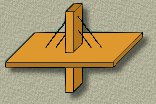
beam bridge
|
A beam bridge is the simplest design. It's very strong over short distances, but isn't strong enough for lengthy ones. A truss bridge is one where the deck is supported by a network of triangles (the strongest polygons because their shapes cannot be distorted) made from girders; a truss bridge can support heavy loads with a relatively small weight.
|

arch bridge
|
In an arch bridge, compression pushes the weight away from the arch and against the side walls and the material of the arch itself. Because it is often a solid structure, there is very little torsion. The Romans were first to build arch bridges, many without any mortar, and some of them still stand today.
|

suspension bridge
|
A suspension bridge hangs from cables anchored at each of its ends. Towers along the span also help support it. The cables are under tension. The cables hold up trusses, which provide the stiffness necessary to support the deck. Suspension bridges are good for long distances.
|

cablestay bridge
|
The cablestay bridge is the most interesting design; the deck is supported by cables from a central tower. Some buildings are now being built this way! Cablestay bridges may be joined to form long spans. The roadway runs on both sides of the tower, so that the stress is applied evenly.
|